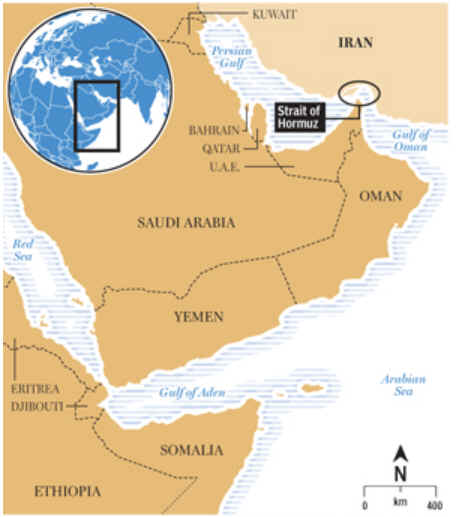
|
||||||||||||
|
|
|
The Strait of Hormuz is the world's most important oil transit chokepoint
January 4, 2012 The U.S. Energy Information Administration (EIA) -The Strait of Hormuz (shown in the oval on the map), which is located between Oman and Iran, connects the Persian Gulf with the Gulf of Oman and the Arabian Sea. Hormuz is the world's most important oil chokepoint due to its daily oil flow of almost 17 million barrels per day (bbl/d) in 2011, up from between 15.5-16.0 million bbl/d in 2009-2010. Flows through the Strait in 2011 were roughly 35% of all seaborne traded oil, or almost 20% of oil traded worldwide.
On average, 14 crude oil tankers per day passed through the Strait in 2011, with a corresponding amount of empty tankers entering to pick up new cargos. More than 85% of these crude oil exports went to Asian markets, with Japan, India, South Korea, and China representing the largest destinations. At its narrowest point, the Strait is 21 miles wide, but the width of the shipping lane in either direction is only two miles, separated by a two-mile buffer zone. The Strait is deep and wide enough to handle the world's largest crude oil tankers, with about two-thirds of oil shipments carried by tankers in excess of 150,000 deadweight tons. Several alternatives are potentially available to move oil from the Persian Gulf region without transiting Hormuz, but they are limited in capacity, in many cases are not currently operating or operable, and generally engender higher transport costs and logistical challenges. •Alternate routes include
the 745-mile Petroline, also known as the East-West Pipeline, across Saudi
Arabia from Abqaiq to the Red Sea. The East-West Pipeline has a nameplate
capacity of about 5 million bbl/d, with current movements estimated at
about 2 million bbl/d. Credit: The U.S. Department of the Interior, Bureau of Land Management Argonne National Laboratory The Oil Shale and Tar Sands Programmatic Environmental Impact Statement, Government Of Alberta Canada,Energy Information Administration, U.S. Department of Energy, OPEC, Shell Oil company, The CIA |


